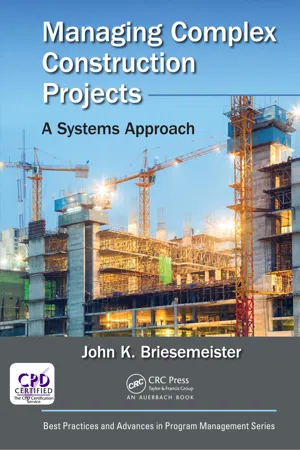![]()
Contents
Dedication
Foreword
Preface
Acknowledgments
About the Author
Chapter 1: Introduction
1.1 Introduction
1.2 Concluding remarks
Chapter 2: Project management system: Part I
2.1 Project management system
2.2 Initiation phase
2.2.1 Project bid evaluation
2.2.2 Project presentation
2.2.3 Project bid submittal
2.3 Planning phase
2.3.1 Outputs
2.4 Concluding remarks
Chapter 3: Project management system: Part II
3.1 Project management outputs
3.1.1 Project construction execution plan
3.1.2 Project engineering plan
3.1.3 Project procurement plan (PPP)
3.1.4 Project logistics plan
3.1.5 Project communications plan (PCP)
3.2 Concluding remarks
Chapter 4: Project management system: Part III
4.1 Project management system
4.2 Project risk management plan (PRMP)
4.2.1 Risk identification key input(s) and risk register
4.2.2 Concluding remarks
4.3 Project document plan (PDP)
4.3.1 Concluding remarks
4.4 Project staffing/resource plan
4.4.1 Site establishment
4.4.2 Site mobilization and remaining phases
4.4.3 Concluding remarks
Chapter 5: Work management system
5.1 Work management system
5.1.1 Civil construction work
5.1.2 Electrical construction work
5.1.3 Mechanical construction work
5.1.4 Instrument and control (I&C) construction work
5.2 Concluding remarks
Chapter 6: Quality management system
6.1 Quality management system
6.1.1 Approved for construction (AFC) drawings
6.1.2 Field change requests (FCRs)
6.1.3 Engineering change notifications (ECNs)
6.1.4 Inspection and test plans (ITPs)
6.1.5 Factory test acceptance packages (FATs)
6.1.6 Method statements (MSs)
6.1.7 Welding process specifications (WPSs)
6.1.8 Field quality plans (FQPs)
6.1.9 Notice of inspection or request for inspection (NOI or RFI)
6.1.10 Nonconformance report (NCR)
6.2 Erection completion certificate (ECC)
6.3 Concluding remarks
Chapter 7: Bringing it all together
7.1 Retirement Community Beta Project
7.1.1 Project Initiation
7.1.2 Project Planning
7.1.3 Project Execution
7.1.4 Project Controlling and Monitoring
7.2 Concluding Remarks
Chapter 8: Lessons Learned from the Field
8.1 Introduction
8.2 Project Management Systems Lessons Learned A. Baseline Schedule
8.3 Work Management Systems Lessons Learned A. Resource Allocation
8.4 Quality Management Systems Lessons Learned
8.5 Closing Remarks
Glossary
Index
![]()
Foreword
The Construction Industry is known for many programs and projects being behind schedule or over budget or experiencing both of these issues given the complexity of the work to be done. John Briesemeister, winner of the 2016 David S. Barrie award from the Project Management Institute, has managed construction projects on various sites around the world and continues to work in this industry. These projects are known for their challenges and complexity as many are in remote areas of the world. His expertise in avoiding cost and schedule issues is extraordinary...He has combined his on-site experience, along with the knowledge gained by his third Master’s degree in Project Management and a previous Master’s degree in Industrial Engineering, to develop the field- based Construction Management approach discussed in this book...He has used this approach on various large, complex construction projects around the world...This book is a “must-read” for anyone working in the construction field or considering it. It also is one that anyone interested in this topic will find interesting and useful...I hope you enjoy reading it and learning from it as much as I did.
— Dr. Ginger Levin, PMP, PgMP, OPM3
![]()
Preface
In this toolbox or book, as some would call it, the reader will find three systems that, used together, can be used to effectively manage the complex construction of large, complex projects. Each of these systems should be viewed as a tool that was designed with over twenty years of formal education and forged in the fires of more than thirty years in the field of onsite construction.
If a person is tired of welding piping in the trenches or bolting up steel structures, there is the Work Management System that will help him or her move out of that trench or off of that structure into a career as a labor superintendent, which could potentially lead this person to managing his or her own construction company someday.
If a person would like to know more about developing a Quality Management program for the construction work onsite, or move from a quality inspector into being a QA/QC Manager, there is the Quality Management System.
Finally, if a person wants to move from college into the exciting field of construction management, with all of its unique challenges, and work with some amazing people, there is the Project Management System that will start him or her on this journey. If this same person wants to see the big picture and effectively paint that big picture, then he or she should learn all three systems in this book and how these systems, when combined, can transform an empty piece of land into a bright new future for millions of people.
![]()
Acknowledgments
I would like to thank Professor Ginger Levin, who inspired me to write this book and worked with me on its development.
I would also like to thank John Wyzalek (Taylor & Francis Group) for providing this opportunity and for his support in the publishing of this book.
In addition, I would like to thank Theron R. Shreve, Director, and Marje Pollack, copy editor and typesetter (DerryField Publishing Services)—who worked tirelessly and with great precision—for their collaboration and dedication in the production of this book.
I also give thanks to the Lord above, who gave me the knowledge and wisdom that made this endeavor possible.
![]()
About the Author
The author, who is a Vietnam Veteran and a licensed Project Management Professional since 2007, began his construction experience as a Site Senior Mechanical Engineer on a large nuclear construction project upon graduation from the University of Minnesota in June 1981.
He has continued working in the power industry as an Engineer, Construction Manager, Site Manager, and Project Manager since the mid- 1980s, and he expanded his academic education to include an MBA in 1994, a Master’s degree in Industrial Engineering (MSIE) in ...
